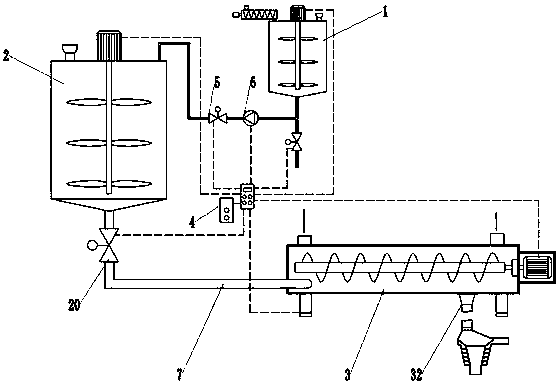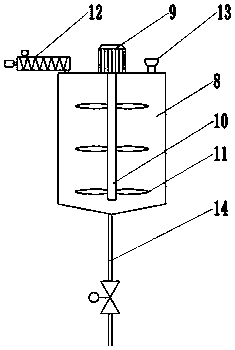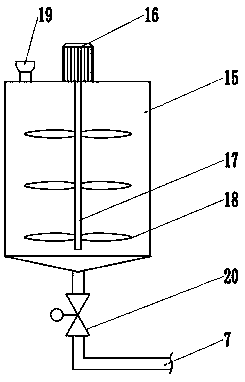Environment-friendly sludge conditioning and drying treatment device
A technology for sludge conditioning and drying treatment, which is applied in the direction of temperature control sludge treatment, dehydration/drying/thickened sludge treatment, grain treatment, etc., which can solve the problems that cannot meet the requirements of sludge process
- Summary
- Abstract
- Description
- Claims
- Application Information
AI Technical Summary
Problems solved by technology
Method used
Image
Examples
Embodiment Construction
[0020] The present invention is realized through the following technical solutions:
[0021] see Figure 1-7 , an environment-friendly sludge conditioning and drying treatment device, including a drug dispensing device 1, a conditioning device 2, a dehydration drying device 3 and a control device 4, the outlet end of the drug dispensing device 1 is connected to the conditioning device 2, and the At least one outlet valve 5 and an electromagnetic pump 6 are connected between the medicament dispensing device 1 and the conditioning device 2, and the conditioning device 2 and the dehydration drying device 3 are connected through a mud outlet pipe 7; the medicament dispensing device 1 includes a medicine dispensing tank 8, a first motor 9, a first stirring shaft 10, a first stirring blade 11, a solid medicine feeder 12, a liquid medicine inlet 13 and a liquid discharge port 14, and the first motor 9 is fixed on Above the medicine dispensing tank 8, the first stirring shaft 10 is f...
PUM
 Login to View More
Login to View More Abstract
Description
Claims
Application Information
 Login to View More
Login to View More - R&D
- Intellectual Property
- Life Sciences
- Materials
- Tech Scout
- Unparalleled Data Quality
- Higher Quality Content
- 60% Fewer Hallucinations
Browse by: Latest US Patents, China's latest patents, Technical Efficacy Thesaurus, Application Domain, Technology Topic, Popular Technical Reports.
© 2025 PatSnap. All rights reserved.Legal|Privacy policy|Modern Slavery Act Transparency Statement|Sitemap|About US| Contact US: help@patsnap.com



